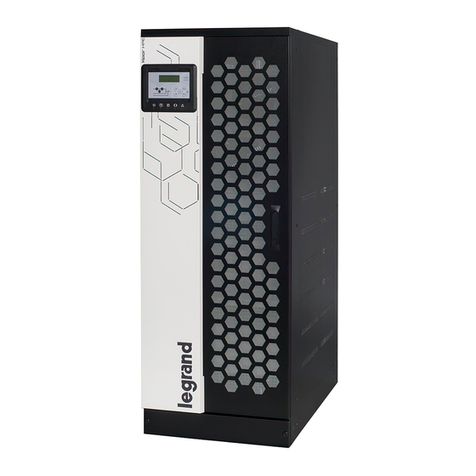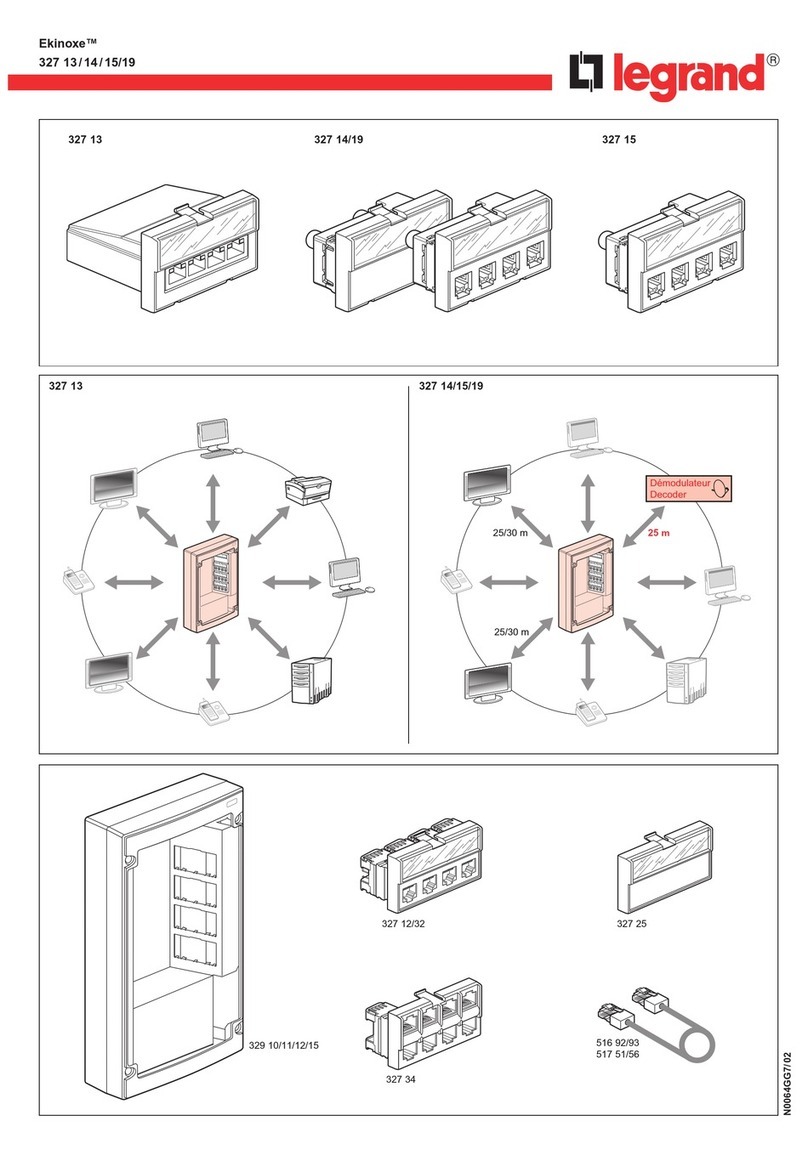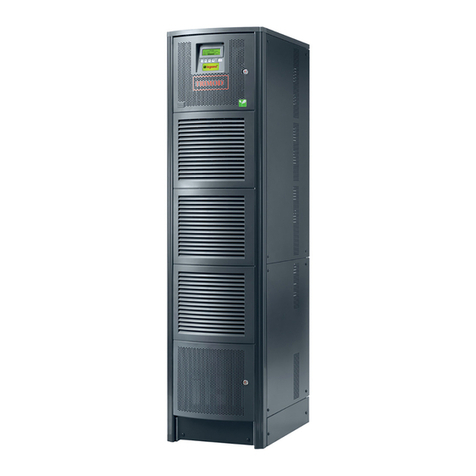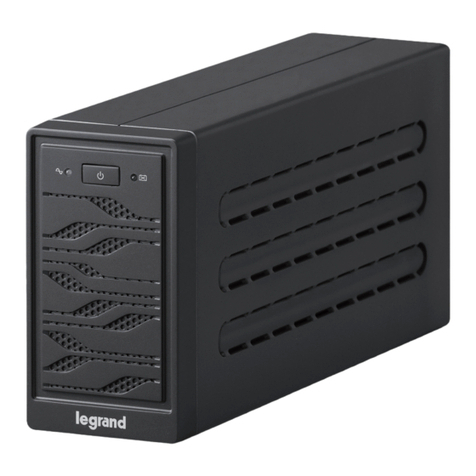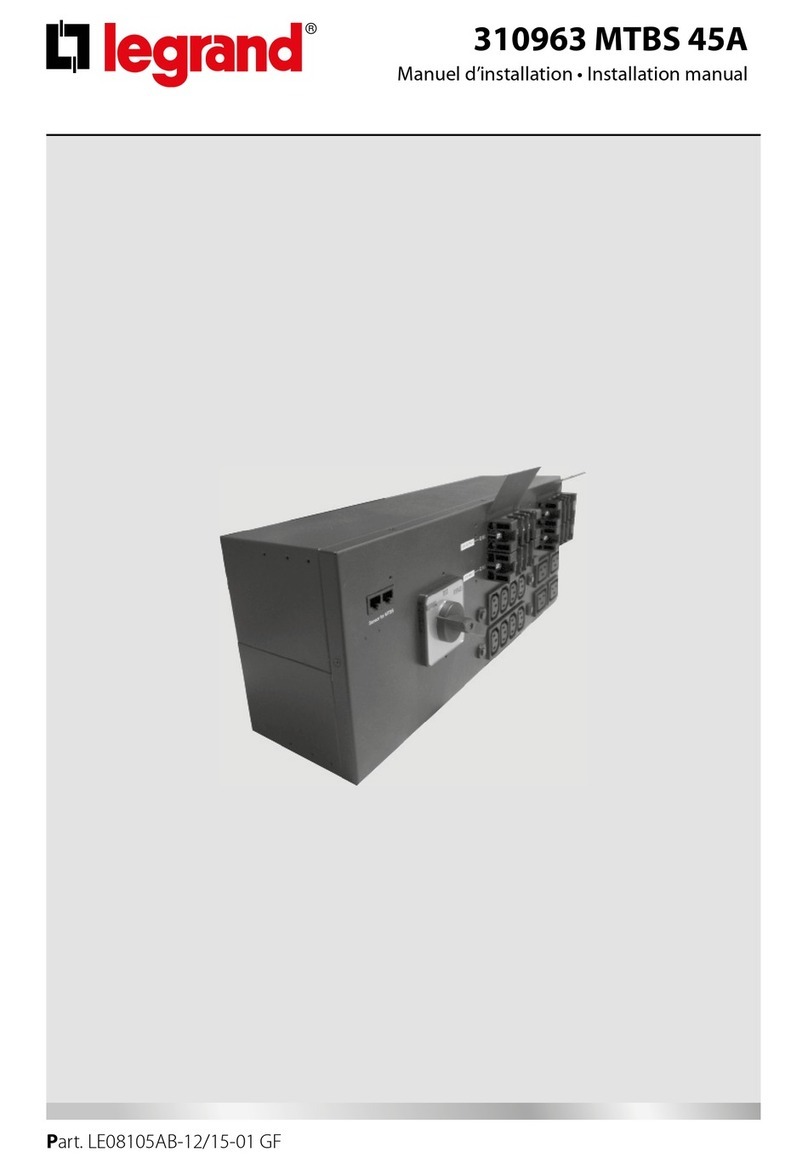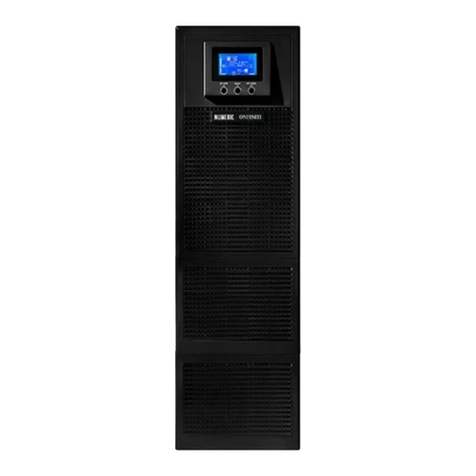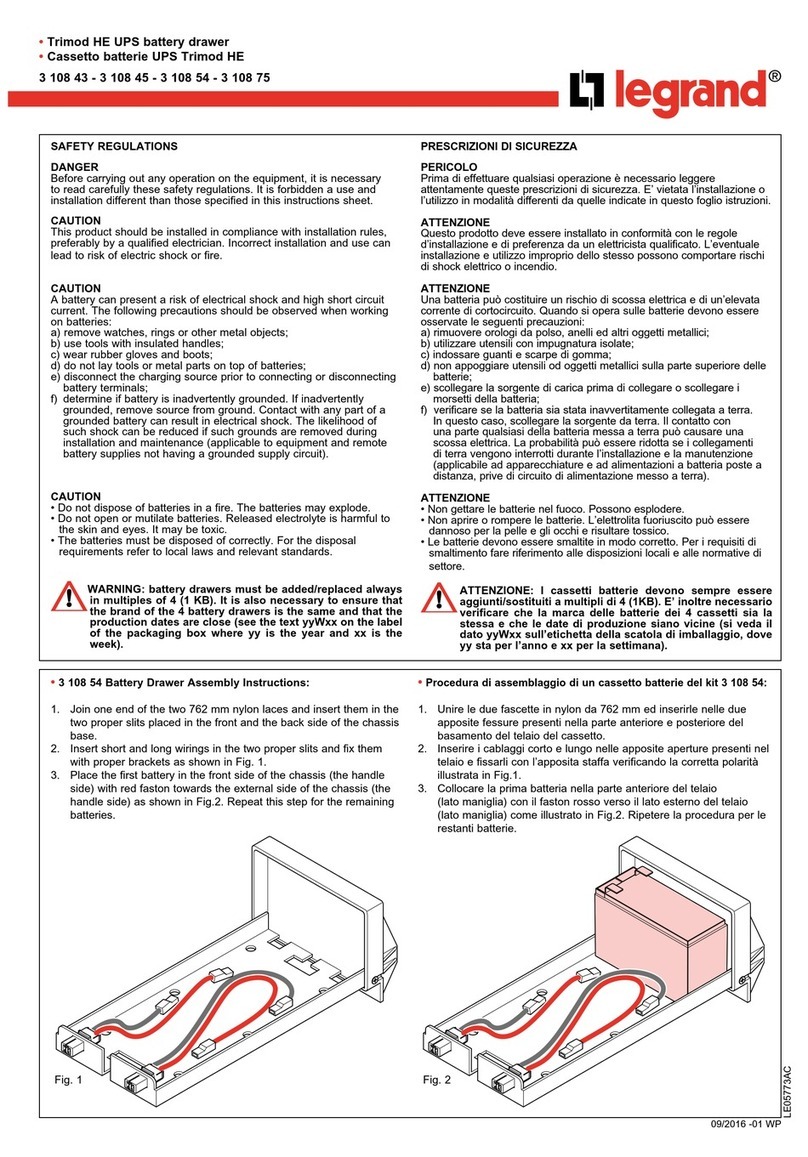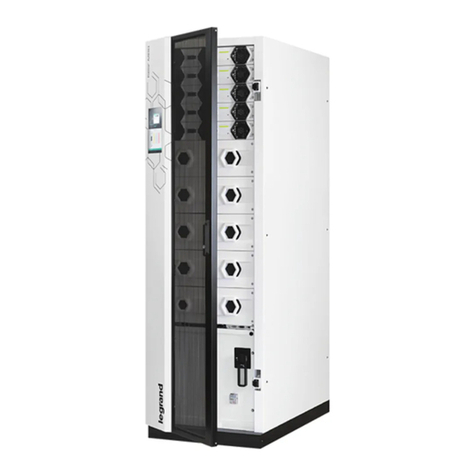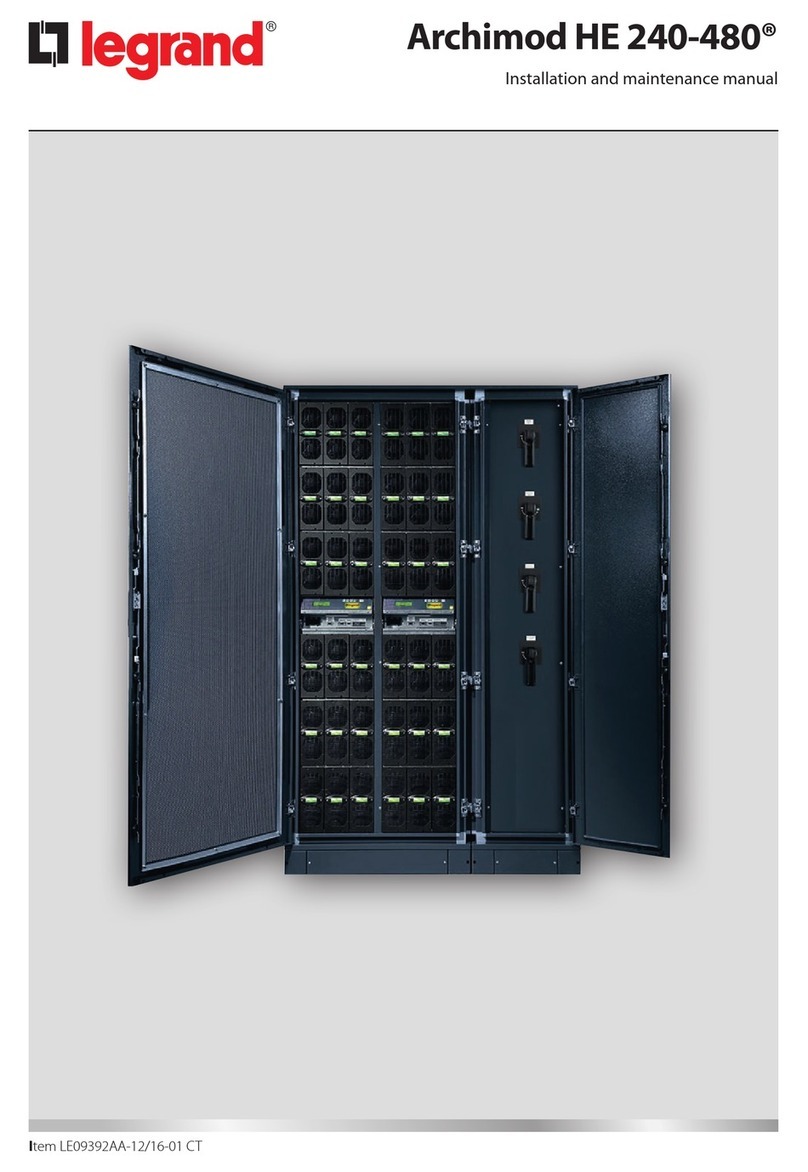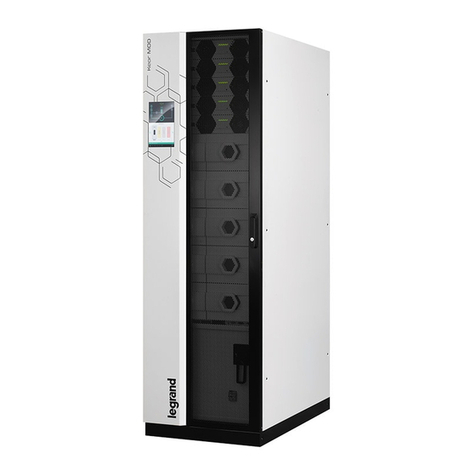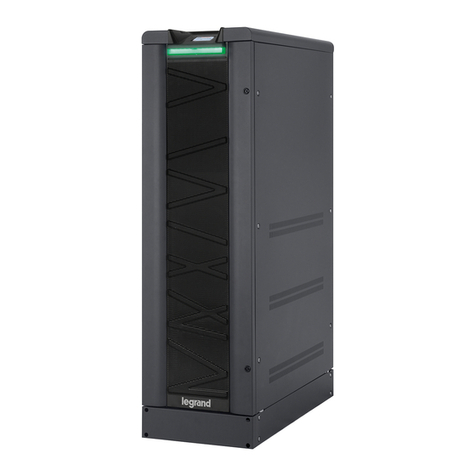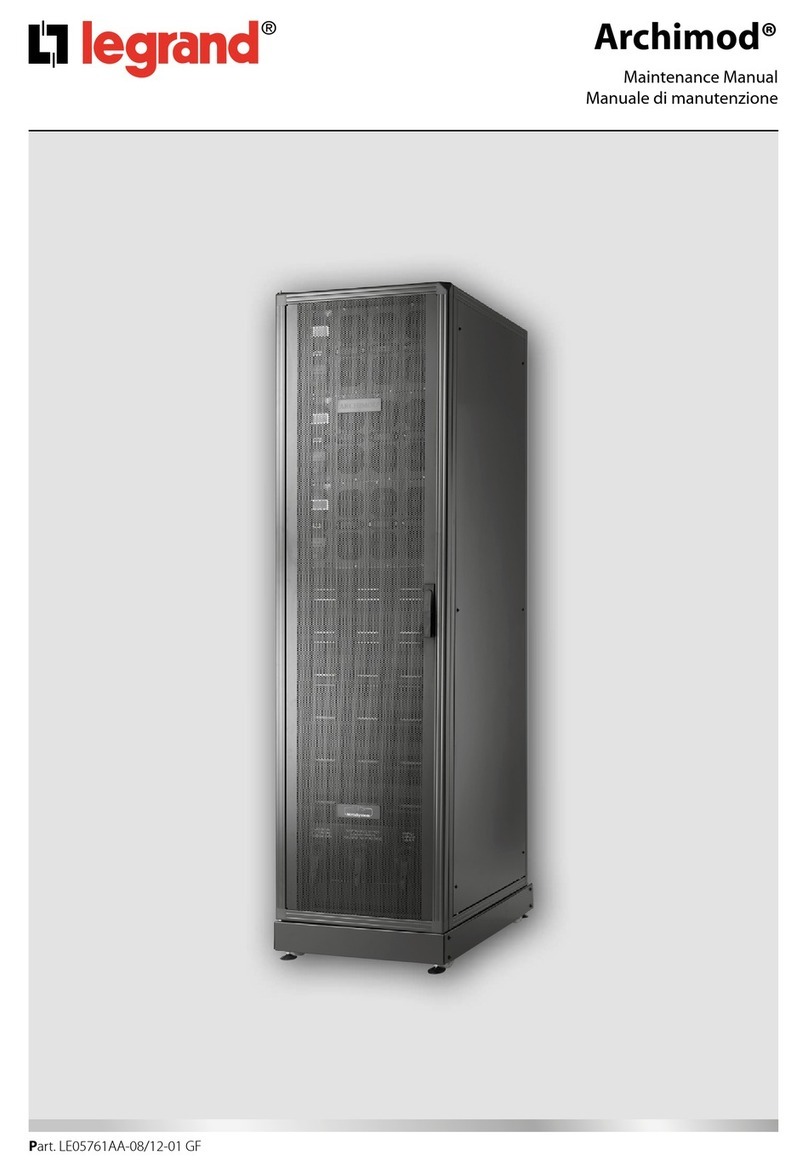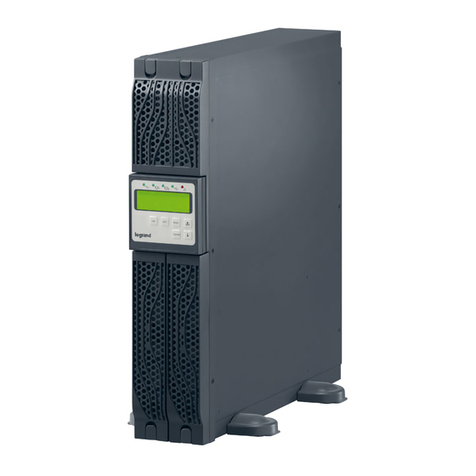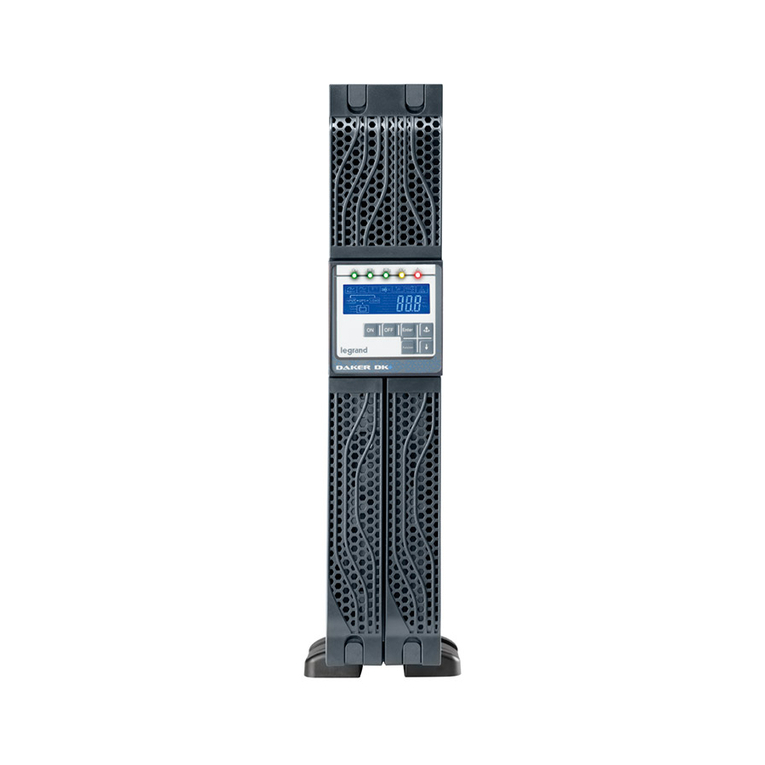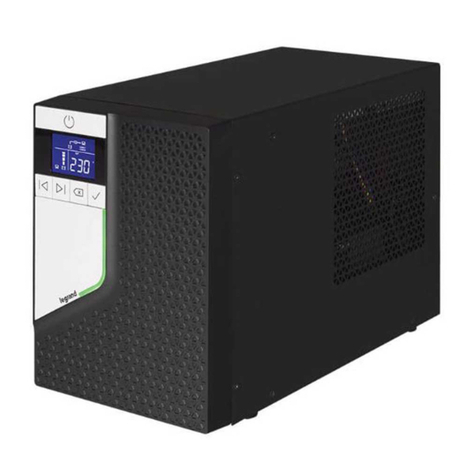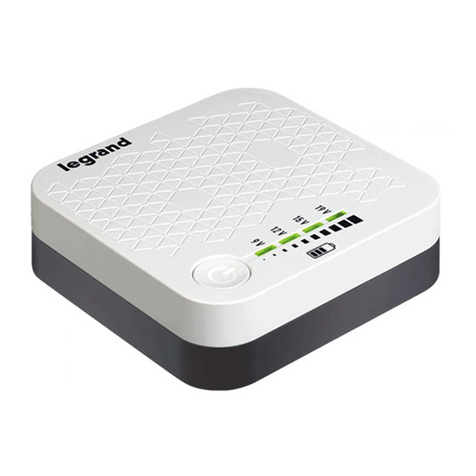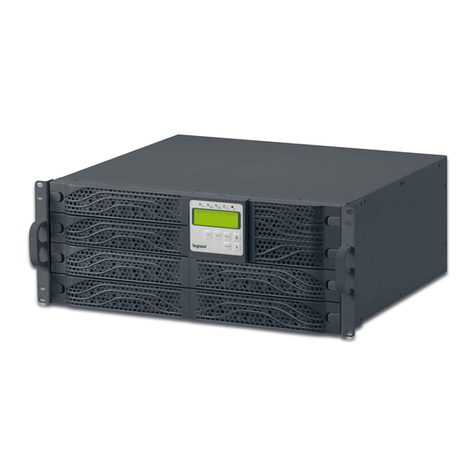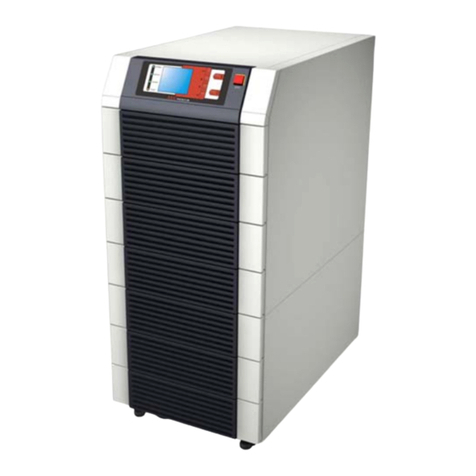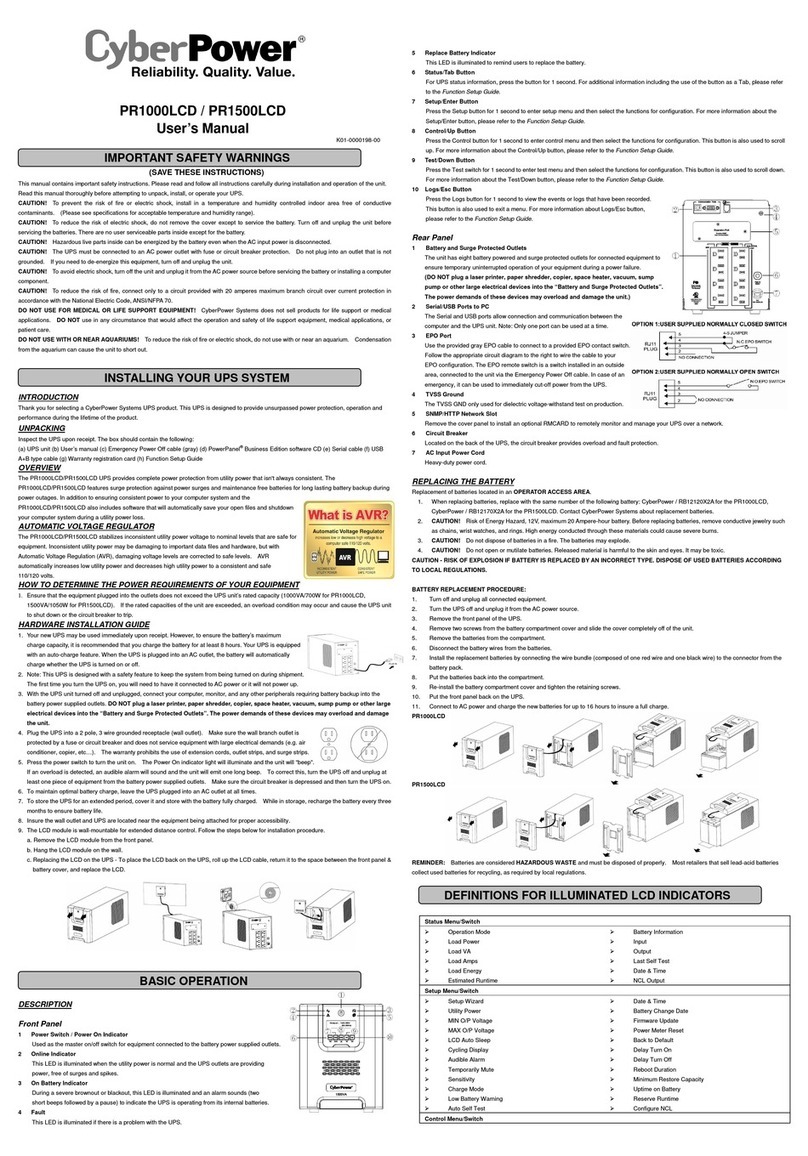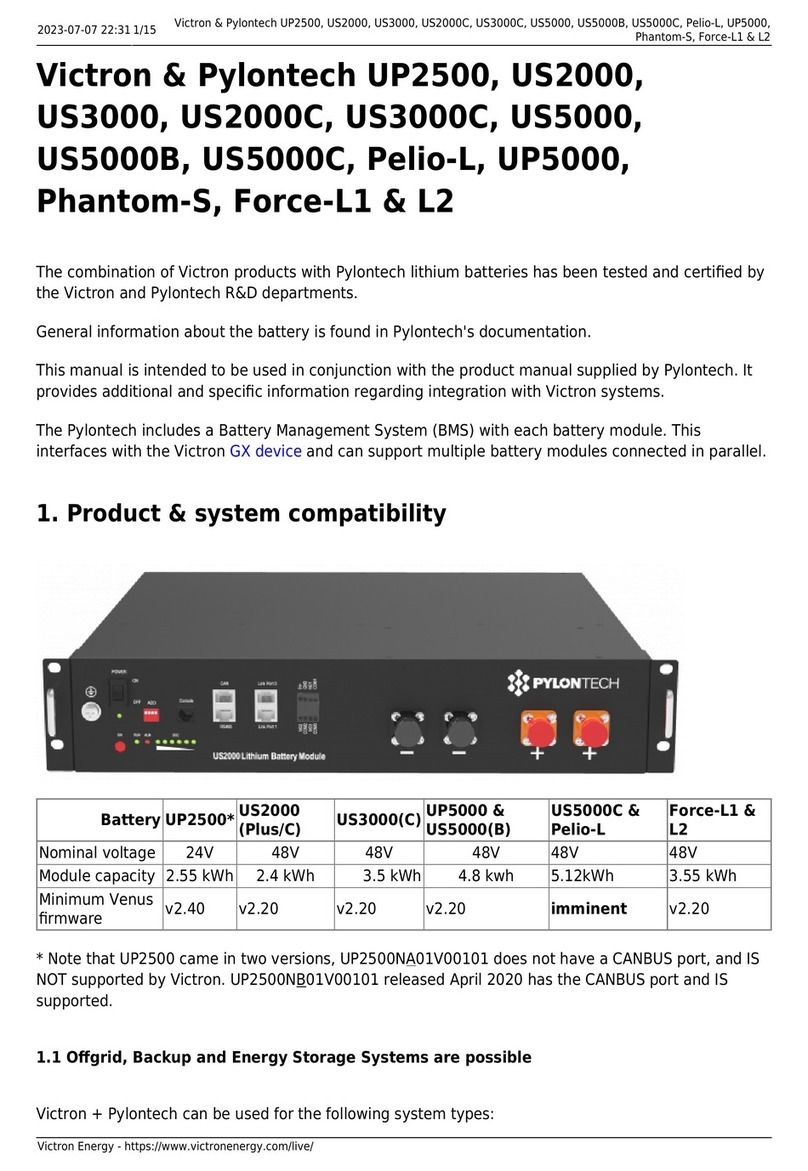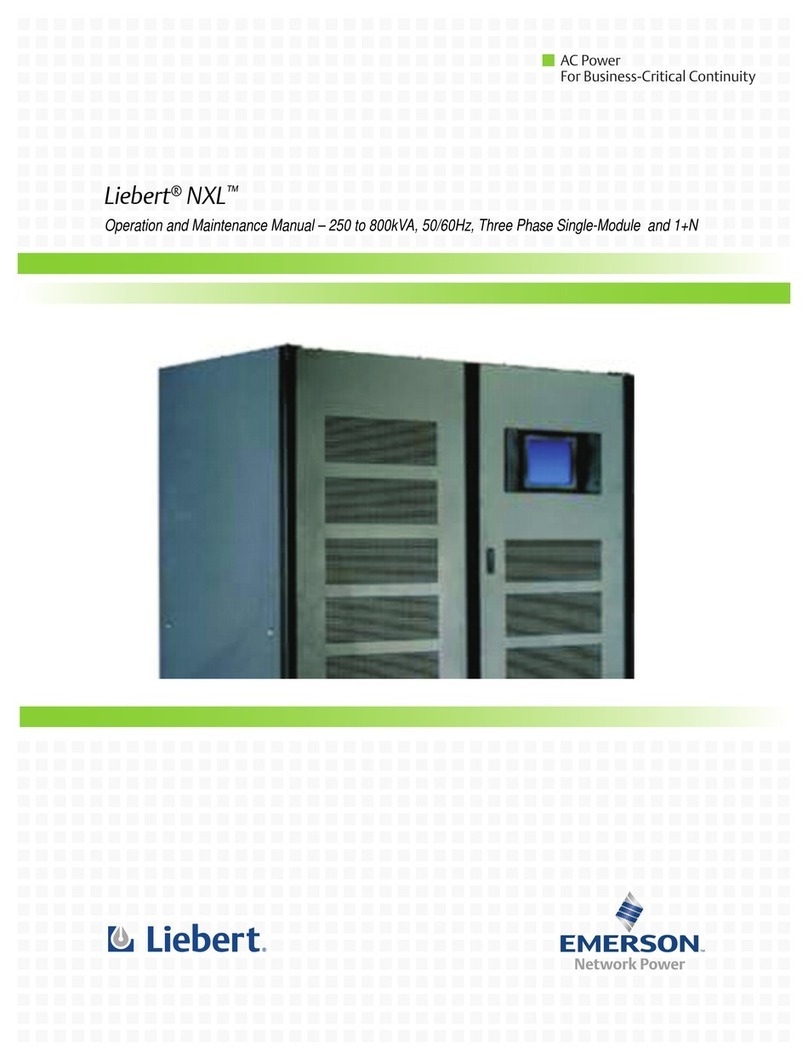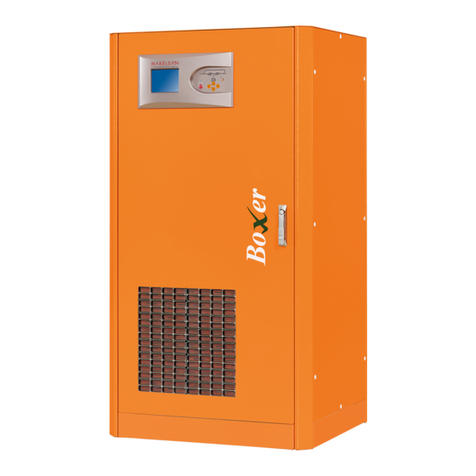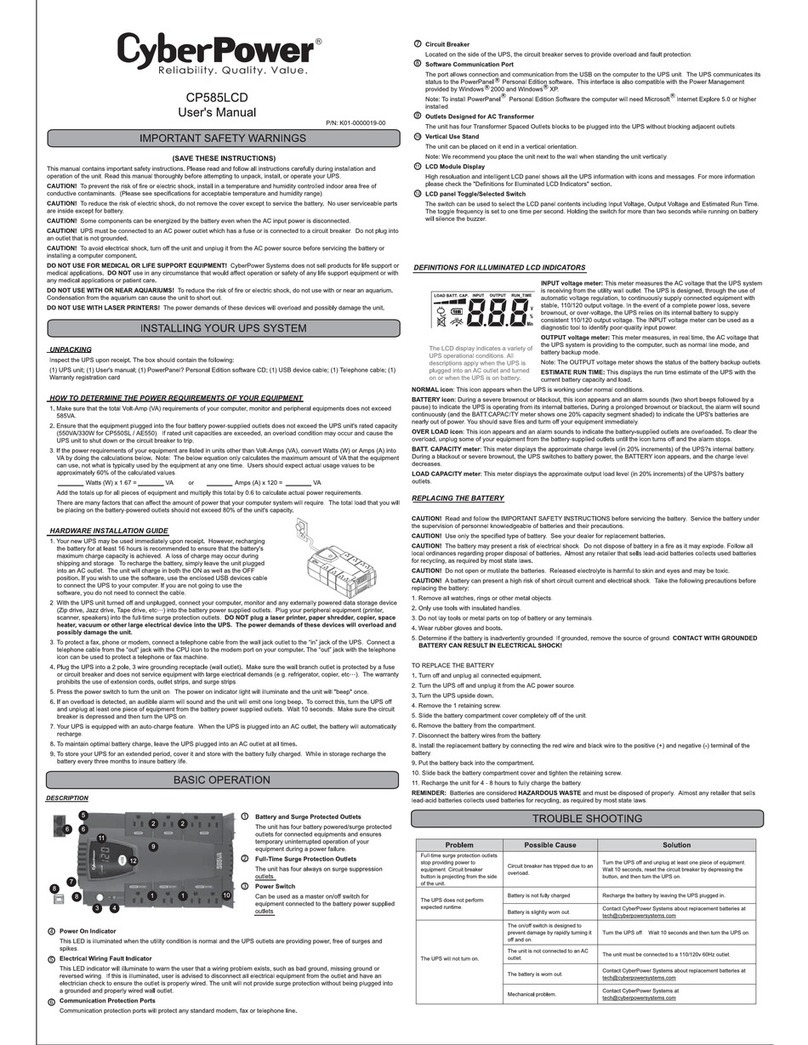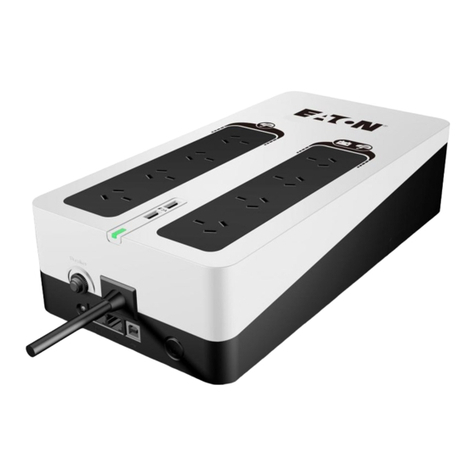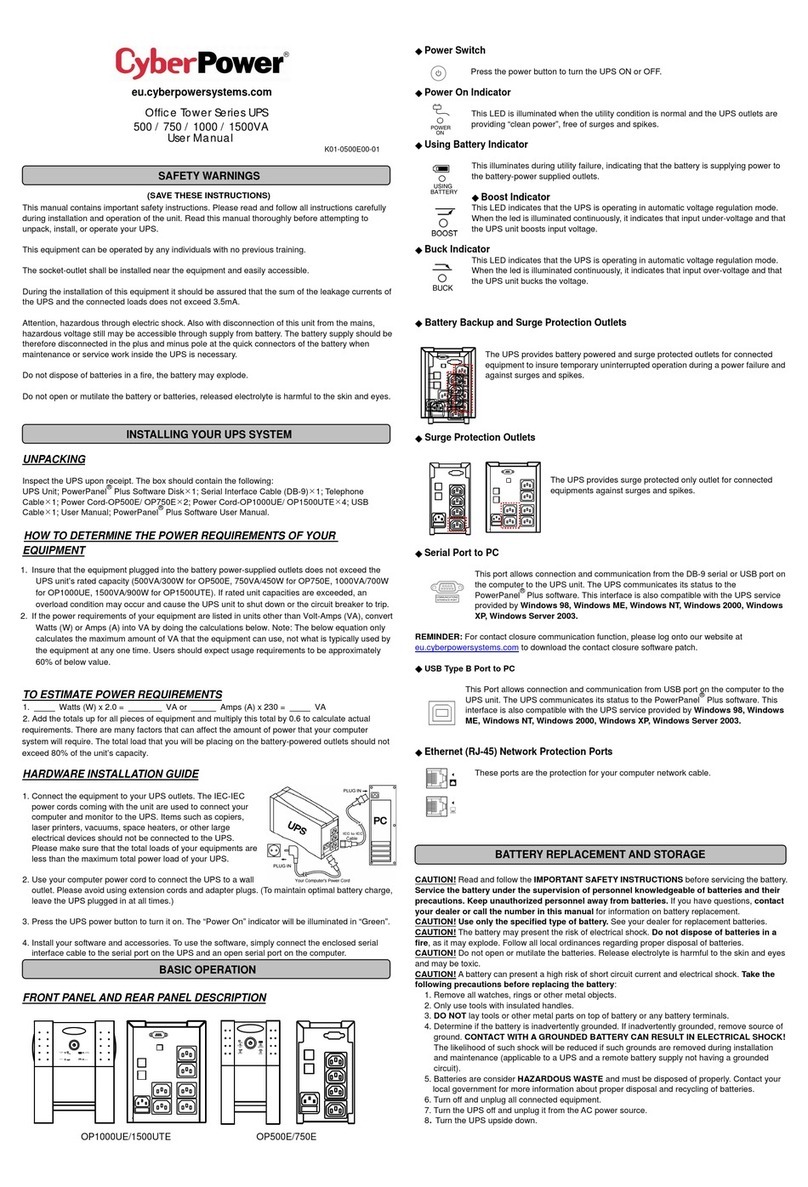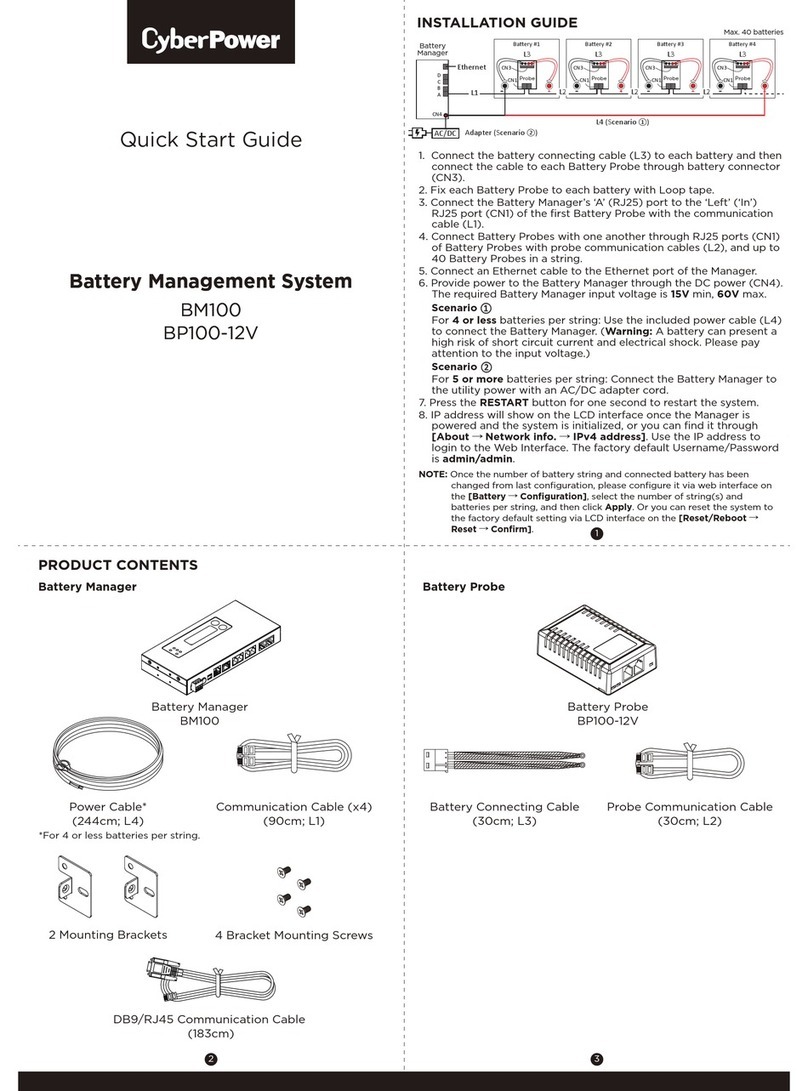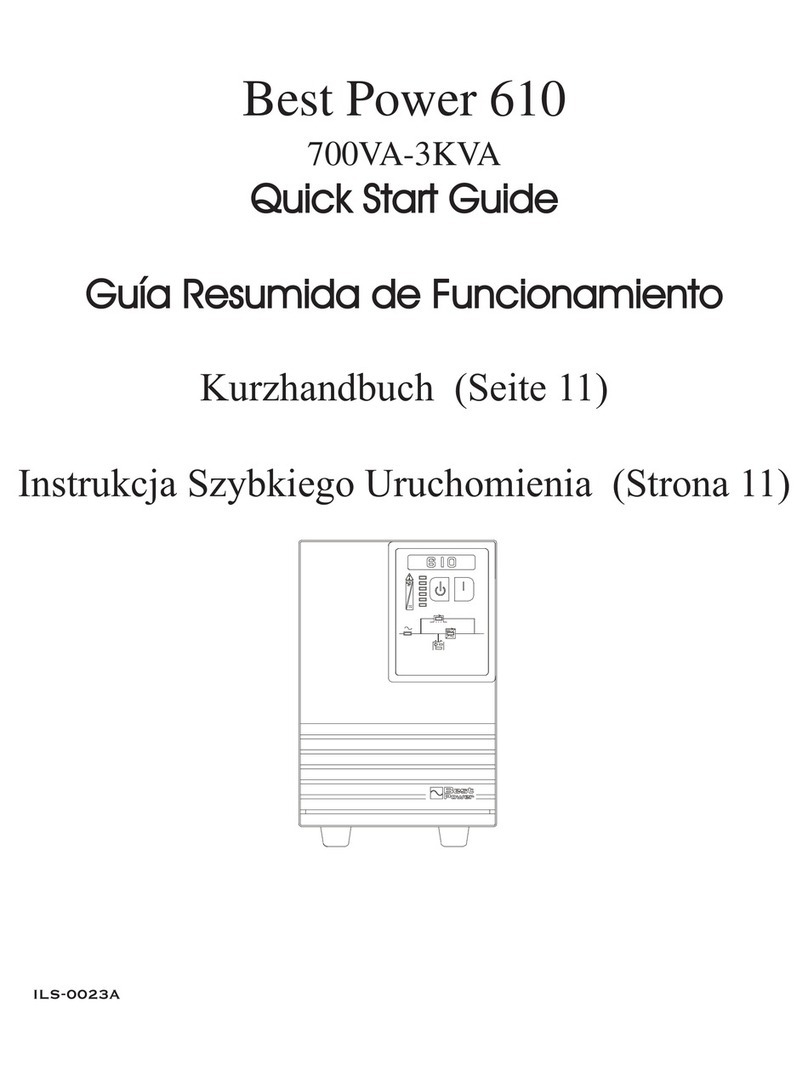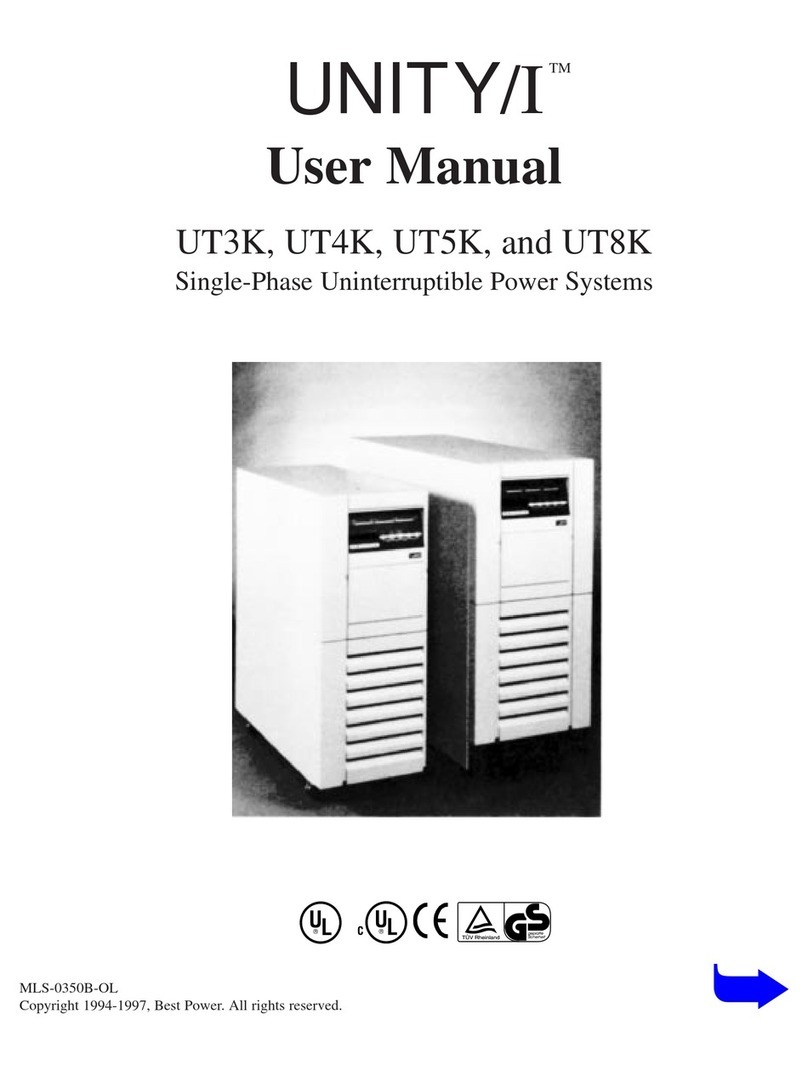
c) Llevar guantes y botas de goma.
d) No apoyar equipos o partes metálicas encima de las baterías.
e) Desconectar la fuente de carga antes de conectar o desconectar la batería.
f ) Determinar si la batería se ha puesto a tierra de forma involuntariamente. En caso de haberse pue-
sto a tierra involuntariamente, retirar la fuente de la tierra. El contacto con una parte de una batería
puesta a tierra puede causar un choque eléctrico.
La posibilidad de dicho choque puede reducirse si dichas puestas a tierra se retiran durante la in-
stalación y mantenimiento (aplicable a equipo y suministros de batería remota sin un circuito de
suministro a tierra).
ATENCIÓN: No tirar las baterías al fuego. Las baterías pueden explotar.
ATENCIÓN: - No abrir o alterar las baterías. El electrólito liberado es perjudicial para la piel y los ojos.
Puede ser tóxico.
• Este SAI es peligroso por los voltajes elevados en sus conexiones de entrada y salida. El contacto con
dichos voltajes puede ser una amenaza para la vida.
• En caso de emergencia, apagar inmediatamente el equipo y desconectar el cable de corriente de la
toma CA para deshabilitar el SAI.
• No permitir que líquidos o cuerpos extraños puedan entrar en el SAI.
• El SAI se contempla para la instalación en el interior en un entorno ventilado y controlado con un
rango de temperaturas comprendidas entre 0°C (+32°F) y +40°C (+104°F) y sin humedad de conden-
sación <95%.
• No instalar el SAI en lugares donde chispas, llamas y otros dispositivos que pueden producir chispas,
humo y gases peligrosos o en caso de presencia de agua y humedad excesiva. Los entornos con
polvo, corrosivos o salinos pueden estropear el SAI.
• No conectar la entrada del SAI a su salida.
• No conectar un alargador o un amortiguador de onda al SAI.
• Mantener un espacio libre de 20 cm detrás del panel posterior del SAI. Evitar la exposición directa a
la luz solar y la instalación cerca de aparatos de producción de calor.
• Desconectar el SAI antes de limpiarlo y no usar líquidos o detergentes en spray.
• No colocar el SAI cerca de equipos que generan campos electromagnéticos fuertes y/o en las proxi-
midades de equipos sensibles a los campos electromagnéticos.
Sicherheitshinweise
Dieses Kapitel enthält wichtige Sicherheitsanweisungen, die bei der Installation, bei Gebrauch und
Wartung der USV beachtet werden müssen.
• Dieses Produkt darf nur durch eine Elektro-Fachkraft eingebaut werden. Bei falschem Einbau bzw.
Umgang besteht das Risiko eines elektrischen Schlages oder Brandes. Vor der Installation die Anlei-
tung lesen, den produktspezischen Montageort beachten. Das Gerät vorbehaltlich besonderer, in
der Betriebsanleitung angegebener Hinweise nicht önen, zerlegen, beschädigen oder abändern. Alle
Produkte von Legrand dürfen ausschließlich von durch Legrand geschultes und anerkanntes Personal
geönet und repariert werden. Durch unbefugte Önung oder Reparatur erlöschen alle Haftungs-, Er-
satz- und Gewährleistungsansprüche. Ausschließlich Zubehör der Marke Legrand benutzen.
• Sollten Sie beim Auspacken des Geräts Schäden bemerken installieren Sie die USV nicht. Verpacken
Sie sie wieder und senden Sie das Gerät an Ihren Händler zurück.
• Bevor Sie die USV einschalten oder an eine Last anschließen, vergewissern Sie sich, dass die USV an
eine richtig geerdete Steckdose angeschlossen ist.
• Die angeschlossene Last darf die auf dem Typenschild der USV angegebene nicht überschreiten.
• Das Auschalten der USV Anlage führt intern nicht dazu das die internen Bauteile Spannungslos sind.
Um die Anlage Spannugsfrei zu schalten, trennen sie den Netzstecker.
• Versuchen Sie nicht die USV zu önen oder zu demontieren. Die Anlage enthält keine vom Nutzer
austauschbaren Teile. Beim Önen des Gehäuses erlischt die Garantie. Zudem besteht Stromschlag-
gefahr, auch wenn der Netzstecker gezogen ist.
• Um die USV zu transportieren, vergewissern Sie sich, dass sie vollkommen ausgeschaltet ist.
• Die Netzsteckdose, die die USV versorgt, muss sich in der Nähe der USV benden und muss leicht
zugänglich sein.
• Schließen sie keine Geräte an die USV, die nicht dafür vorgesehen sind. Das sind z.b. medizinische,
Lebenserhaltende oder Haushaltsgeräte.
• Die USV hat eine eigene interne Energiequelle (Batterien). Wenn die USV eingeschaltet ist, und kein
Wechselstrom vorhanden ist, liegt an den Ausgangsbuchsen eine gefährliche Spannung an.
• Die Batterie in der USV ist nicht vom Benutzer ersetzt werden. Die Wartung der Batterien ist aus-
schließlich zugelassenem Fachpersonal gestattet.
• ACHTUNG Die Batterie ist wegen Stromschlaggefahr und dem hohen Kurzschlussstrom gefährlich. Fol-
gen Sie nachstehenden Vorsichtsmaßnahmen, wenn Sie an den Batterien arbeiten:
a. Tragen Sie keine Uhren, Ringe oder andere Metallgegenstände.
b. Verwenden Sie nur Werkzeuge mit isoliertem Gri.
c. Tragen Sie Gummihandschuhe und Gummistiefel.
d. Lassen Sie keine Werkzeuge oder Metallgegenstände auf den Batterien liegen.
e) Trennen Sie die Stromquelle ab, bevor Sie die Batterien anschließen oder abtrennen.
f) Kontrollieren Sie, ob die Batterie unbeabsichtigt geerdet ist. Sollte dies der Fall sein, trennen Sie
die Quelle von der Erde ab. Der Kontakt mit einer geerdeten Batterie stellt Stromschlaggefahr dar.
Die Wahrscheinlichkeit eines Stromschlags kann reduziert werden, wenn die Erdung bei der Installa-
tion und Wartung abgetrennt ist (gilt für Geräte und ferngeschaltete Batterieversorgung, ohne einen
geerdeten Versorgung).
ACHTUNG: Batterien nicht ins Feuer werfen. Sie könnten explodieren.
ACHTUNG: Die Batterien nicht önen oder beschädigen. Das Elektrolyt ist für Haut und Augen ge-
fährlich. Vorsicht Giftig!
• Diese USV hat gefährlich hohe Spannungen an den Eingangs- und Ausgangsverbindungen. Der Kon-
takt mit diesen Spannungen kann lebensgefährlich sein.
• Im Notfall schalten Sie das Gerät sofort aus und ziehen Sie das Netzkabel aus der Wechselstromver-
sorgung, um die USV abzuschalten.
• Es dürfen keine Flüssigkeiten oder ein Fremdkörper in die USV eindringen.
• Die USV ist für den Gebrauch im Inneren, in einer belüfteten, kontrollierten Umgebung mit einer Tem-
peratur von 0°C (+ 32°F) bis + 40°C (+ 104°F) und einer nicht kondensierenden Feuchtigkeit <95%.
• Installieren Sie die USV nicht an Orten wo Funken oder Flammen, Rauch oder gefährliches Gas durch
andere Geräte entstehen können, oder in der Nähe von Wasser und in übermäßig feuchten Räumen.
Staubige, korrosive und salzige Umgebungen können die USV beschädigen.
• Schließen sie den USV Eingang nicht an den eigenen USV Ausgang an.
• Verwenden Sie keine Steckerleiste oder einen Überspannungsschutz mit der USV.
• Halten Sie einen Abstand von 20 cm zur USV-Rückwand ein. Vermeiden Sie es, das Gerät direktem
Sonnenlicht auszusetzen oder es in der Nähe von Wärmequellen zu installieren.
• Ziehen Sie den Stecker der USV aus der Steckdose ab, bevor Sie das Gerät reinigen und verwenden
Sie zur Reinigung keine Flüssigkeit oder Sprayreiniger.
• Stellen Sie die USV nicht in der Nähe von Geräten auf, die starke elektromagnetische Felder erzeugen
und/oder gegen elektromagnetische Felder empndlich sind.
DE
Consignas de seguridad
Esta sección contiene instrucciones de seguridad importantes que se han de seguir siempre durante la
instalación, el uso y el mantenimiento del SAI.
• Este producto debe instalarse conforme a las normas de instalación y preferiblemente por un elec-
tricista cualicado. Una instalación y una utilización incorrectas pueden entrañar riesgos de choque
eléctrico o de incendio. Antes de efectuar la instalación, leer las instrucciones, tener en cuenta el
lugar de montaje especíco del producto. No abrir, desmontar, alterar o modicar el aparato salvo
que esto se indique especícamente en las instrucciones. Todos los productos Legrand deben ser
abiertos y reparados exclusivamente por personal formado y habilitado por Legrand. Cualquier aper-
tura o reparación no autorizada anula la totalidad de las responsabilidades, derechos a sustitución y
garantías. Utilizar exclusivamente los accesorios de la marca Legrand.
• En caso de detectar daños visibles en el producto durante el desembalaje, no instalar el SAI, reemba-
larlo y devolverlo a su revendedor o distribuidor.
• Antes de poner en marcha el SAI o conectar equipos de carga, asegurarse de que el SAI se haya
conectado a un suministro eléctrico con una puesta a tierra adecuada.
• La carga aplicada no ha de superar la indicada en la etiqueta trasera del SAI.
• El pulsador de ON/OFF del SAI no aísla eléctricamente las partes internas. Desconectar el SAI del
enchufe de corriente para aislarlo.
• No intentar abrir o desmontar el SAI; no contiene partes que se puedan sustituir por el usuario. Abrir la
carcasa anula la garantía y comporta el riesgo de choque eléctrico incluso con la clavija desconectada.
• Asegurarse de que el SAI se encuentre completamente apagado durante el transporte.
• La toma de la red que alimenta el SAI ha de instalarse cerca del SAI y resultar fácilmente accesible.
• No conectar elementos no relacionados con el PC, tales como equipos médicos, equipos de mante-
nimiento de la vida y equipos eléctricos a la salida del SAI.
• El SAI dispone de una fuente energética interna propia (baterías). Con el SAI encendido y sin corriente
CA disponible, en las tomas de salida hay tensión peligrosa.
• La batería dentro del SAI no piede ser sustituido por el usuario. Solamente personal autorizado a
intervenir en caso de riesgo eléctrico puede efectuar el mantenimiento de las baterías.
• ATENCIÓN: Una batería puede presentar un riesgo de choque eléctrico y una corriente de cortocir-
cuito elevada. Tomar las siguientes precauciones para manejar las baterías:
a) Quitarse relojes, anillos y otros objetos metálicos.
b) Usar equipos con empuñaduras aisladas.
ES
Меры предосторожности
В данном разделе содержатся важные указания по правилам техники безопасности при монтаже,
использовании и обслуживании ИБП.
• Монтаж данного изделия должен выполняться квалифицированным электриком в соответствии
с инструкцией производителя. Неправильная установка может привести к опасности возгорания
или поражения электрическим током. Перед началом монтажа внимательно изучите инструкции
и требования к месту установки изделия. Не вскрывайте корпус и не изменяйте или модифици-
руйте изделие за исключением случаев, указанных в инструкциях. Открывать и ремонтировать
все изделия Legrand разрешается только специалистам, подготовленным и уполномоченным
компанией Legrand. Любая несанкционированная разборка и ремонт изделия неавторизован-
ным персоналом является законным основанием к прекращению гарантийного обслуживания,
ремонта или замены. Разрешается использовать только аксессуары производства Legrand.
• При обнаружении любого видимого повреждения во время распаковки изделия не устанавли-
вайте ИБП, а запакуйте и возвратите его продавцу или дистрибьютору.
• Перед началом работы с ИБП или подключением любой нагрузки убедитесь, что ИБП подклю-
чен к правильно заземленному источнику питания.
• Мощность подключённой нагрузки не должна превышать мощность ИБП, которая указана на
паспортной табличке на задней стороне изделия.
• Кнопка ВКЛ/ОТКЛ. ИБП не имеет гальванической развязки с внутренними элементами изделия. Для
изоляции ИБП необходимо отсоединить его от электросети, вытащив шнур питания из розетки.
• Категорически запрещается вскрывать корпус и разбирать ИБП; он не содержит деталей, заменяе-
мых пользователем. Вскрытие корпуса влечет за собой отмену гарантии и может привести к пора-
жению электрическим током, даже если вилка кабеля питания извлечена из розетки.
• Перед транспортировкой ИБП выключите питание и отсоедините от него все кабели.
• Розетка электросети должна находиться в непосредственной близости от ИБП и быть легко доступна.
• К выходу ИБП запрещается подключать любое оборудование, не относящееся к компьютерно-
му: медицинскую аппаратуру, средства жизнеобеспечения, бытовые электроприборы.
• Запрещается подключать к ИБП лазерные принтеры, так как они имеют высокий пусковой ток.
• ИБП имеет собственный источник электроэнергии – аккумуляторные батареи. Если ИБП включен,
когда напряжение в электросети отсутствует, на его выходах присутствует опасное напряжение.
• Батарея внутри ИБП не может быть заменена пользователем. Обслуживать батареи разре-
шается только персоналу, имеющему соответствующий допуск по электробезопасности.
• ОСТОРОЖНО: Батарея представляет риск с точки зрения поражения электрическим током и ко-
роткого замыкания. Соблюдайте следующие меры предосторожности при обращении с батареями:
a) Снимите часы, кольца и другие металлические предметы.
b) Используйте инструменты с изолированными ручками.
c) Работайте в резиновых перчатках и диэлектрических ботах.
d) Не кладите на батареи инструменты и металлические предметы.
e) Перед тем, как отсоединять и присоединять батарею, обесточьте ИБП, чтобы прекратить ее зарядку.
f ) Убедитесь, что батарея не была непреднамеренно подключена к земле. Если это не так, то
отсоедините ее от земли. Прикосновение к любой части батареи, подключенной к земле, может
вызвать поражение электрическим током.
Следует принять меры к исключению возникновения соединений с землей во время монтажа
и подключения (размещать оборудование следует так, чтобы оно не контактировало с цепью
заземления).
ВНИМАНИЕ: Запрещается бросать батареи в огонь, они могут взорваться!
ВНИМАНИЕ: Запрещается деформировать или вскрывать батареи. Вытекающий электролит
опасен для кожи и глаз. Кроме того, от токсичен.
• На входных и выходных разъемах ИБП присутствует опасное напряжение. Прикосновение к
ним опасно для жизни.
• В случае опасности немедленно выключите ИБП кнопкой и вытащите шнур питания из розетки
электросети.
• Не допускайте попадания внутрь ИБП жидкостей и посторонних предметов.
• ИБП предназначен для установки в вентилируемом помещении с контролируемым микрокли-
матом (при температуре 0-40 °C и относительной влажности воздуха <95%).
• Запрещается устанавливать ИБП в местах, где возможно образование искр и дыма, появление
пламени, присутствие взрывоопасных газов, наличие воды или чрезмерной влажности. Запы-
ленная, коррозийная или соленая среда может вызвать повреждение ИБП.
• Запрещается подсоединять вход ИБП к его выходу.
• Запрещается подключать к ИБП блоки розеток или ограничители перенапряжений.
• Сзади ИБП следует оставить 20 см свободного пространства. Запрещается устанавливать ИБП
под прямыми солнечными лучами и рядом источников тепла, такими как обогреватели и печи.
• Перед очисткой ИБП его следует обесточить. Запрещается очищать ИБП водой или спреем.
• Не устанавливайте ИБП рядом с оборудованием, излучающим сильные электромагнитные
поля и/или устройствами, обладающими повышенной чувствительностью к электромагнит-
ным полям.
RU
4

